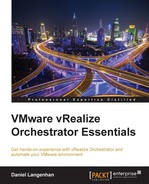The Orchestrator Appliance is a Linux-based appliance that comes completely preconfigured and ready to run. An appliance is basically a fully installed and configured VM with an operating system, also known in the industry as shrink-wrapped. In this chapter, you will learn how to deploy the appliance as well as base configure it. Along the way, we will look at the following topics:
- Downloading vRO
- Installing vRO
- Accessing Orchestrator
- Base configure the Orchestrator Appliance
- The Orchestrator configuration tools
Before we start, we should get our heads around a few things.
First of all, we need to download the appliance in the OVA format from the VMware website:
- Open a browser and visit www.vmware.com.
- Click on Downloads.
- Select Download Product next to the VMware vSphere section.
- Scroll down to
Standardand then click on Go to Downloads next to VMware vRealize Orchestrator Appliance - Scroll down until you find the OVA download, as shown in the following screenshot:

- Now, click on Download Now.
- You will be asked for your VMware credentials. Enter them and click on Log In.
- Agree and click on Accept for the EULA.
- Download the OVA to a location from where you can access vCenter (or on your desktop if you are using VMware Workstation).
If you don't have a valid VMware license, you can acquire an evaluation license for vSphere. At the time of writing, there is no specific Orchestrator trial available, but Orchestrator can be used with the free vSphere trial version.
To do so, perform the following steps:
- Visit www.vmware.com, the VMware webpage.
- Browse Products | vSphere.
- Select Try for Free.
- If you have a VMware account, log in now. If you don't have one, create one.
- You should receive an email with your evaluation license key.
- Now, follow the previous set of instructions.
Orchestrator Appliance 6.0.2 requires the following virtual resources:
|
CPU |
2 vCPU with at least 2.0 GHz |
|
Memory |
3 GB |
|
Disk space |
12 GB |
|
Network |
1x Network 1x IP (DHCP possible) |
The next important thing is to have an IP as well as a hostname for the appliance that is registered in the DNS. You can use DHCP, but for best results you should have a dedicated IP and FQDN for Orchestrator.
Make sure that you can resolve the hostname full, short, and reverse. Lets look at the following example: The hostname of a VM is vRO.mylab.local and its IP is 192.168.220.128. As the VM doesn't exist yet, the pings will fail. However, the DNS reply should still be shown. If this works correctly, we can go on. The following table shows the commands that you should run as well as the results that you should see:
|
Resolve type |
Command |
Result |
|---|---|---|
|
Full |
|
|
|
Short |
|
|
|
Reverse |
|
|
The Orchestrator Appliance requires the following open ports:
|
Source |
Target |
TCP port(s) |
Description |
|---|---|---|---|
|
Web browser |
Orchestrator VM |
80 8281 |
The Orchestrator home page |
|
Web browser |
Orchestrator VM |
8283 |
The Orchestrator configuration |
|
Orchestrator Client |
Orchestrator VM |
8286 8287 |
Orchestrator Client's Java communication |
|
Orchestrator VM |
MS SQL |
1433 |
Needed only for MS SQL DB access |
|
Orchestrator VM |
Oracle |
1521 |
Needed only for Oracle DB access |
Orchestrator requires one group with at least one user. The group is used as the Orchestrator Administrator group, and the user should be a member of this group.
You can either create a dedicated group and at least one user for Orchestrator, or use an existing group and users. The group and users can be created either in SSO or in the Active Directory that is attached to your SSO.
If you are using new users and groups in AD, perform the following steps:
- Add a new global security group to your AD, such as
vROAdmins. - Create a new user in your AD, such as
vROAdmin, and make it a member of the new group that you created. - Using the vSphere Web Client, add the new group to your vCenter with the Administrator role.
- Log out of the Web Client, try to log in as the new user, and check whether it works.
Orchestrator needs a database. The appliance comes with a preconfigured internal PostgreSQL database that is ready for use. However, for a production environment, the internal database is not good enough as there are no means to backup the DB or run maintenance. A production Orchestrator installation should use an external PostgreSQL, MS SQL, or Oracle database. It is not a good idea to use the vCenter database.
VMware recommends that the database should have at least a size of 1 GB. For a test installation, a size of 100 MB is fine.
If you want to create a new MS SQL database, perform the following steps:
- Open MS SQL.
- Create a new database and give it a name, such as
vRODB. - Create a new login. You can use either the new AD account that you previously created or a SQL user.
- Make sure that the DB user has the
sysadminrole and is adb_Ownerof the new database.
After installing and configuring Orchestrator, the DB user only needs the read and write permissions. The SysAdmin role is only needed for installation or update purposes.
